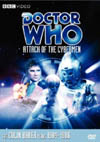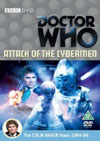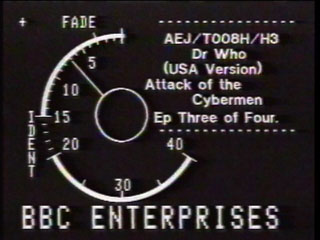Attack of the Cybermen
 |
 |
 |
DVD NTSC
Region 1




|
DVD PAL
Region 2


|
VHS Video
NTSC


NTSC


PAL
 TIN TIN

|
|
(Doctor Who Story No. 138, starring Colin Baker)
- written by Paula Moore
or, written by Eric Saward under the name "Paula Moore"
and repeatedly denied.
- directed by Matthew Robinson
- produced by John Nathan-Turner
- music by Malcolm Clarke
- 4 episodes @ 25 minutes each, or
2 episodes @ 45 minutes each
|
Story: While testing repairs to the TARDIS's
chameleon circuit, the Doctor and Peri respond
to an alien distress signal and get caught up in
a web of intrigue between the original Cybermen
invasion of Earth from Mondas in 1986, and a secret
project being undertaken from their secondary base
on the planet Telos. Understanding how the mercenary
Lytton fits into the puzzle may keep the Doctor guessing
until the end....
|
|
DVD Extras include:
- Audio commentary by actors Colin Baker (The Doctor),
Nicola Bryant (Peri),
Terry Molloy (Russell),
and Sarah Berger (Rost).
- Making-of featurette (27 min.) adding
script editor (writer?) Eric Saward,
director Matthew Robinson,
consultant Ian Levine, and
film cameraman Godfrey Johnson.
- "The Cyber Story" history of the Cybermen featurette (23 min.),
including
Cyber Lieutenant Mark Hardy,
former director Morris Barry,
costume designers Sandra Reid and Dinah Collins,
and Cyber voice Roy Skelton.
- "Human Cyborg" interview of Professor Kevin Warwick (8 min.)
- Isolated Music Score by Malcolm Clarke
- Pop-up Production Note Subtitles
- The Cyber Generations - music montage video (8 min.)
- Photo Gallery
Buyers' Guide Review
by Martin Izsak
|
|
(A more in-depth analysis, containing "SPOILERS" and intended
for those who have already seen the program, can be accessed
here.)
|
Doctor Who makes a bit of a welcome return to many of its roots
with this story, which goes far to help anchor new Doctor Colin Baker
into his role. Though not a truly grand story itself, it is a vast
improvement on the previous two tales, and though it can hardly be
thought of as non-violent, its writer(s) seem to have learned that less
excessive amounts of violence actually leave more room for a better
focus on story and atmosphere. And even if his relationship with Peri
isn't producing
a lot of good scenes, Colin Baker has found his characterization of the
Doctor here, and that at least is finally working well.

|
Officially, this is the beginning of season 22, even if
the previous story
felt more like a beginning. Season 22 is unique for experimenting
with one of the biggest format changes ever for Doctor Who. The stories
remained more or less the same total length as usual,
but were now written and produced to be divided up differently.
Instead of 4 episodes per story, at 25 minutes each, the new norm was
to be on average 2 episodes per story, at 45 minutes each.
Of course, any benefit
this experiment had was purely for the show's native British audience,
as the 45-minute episodes were again arbitrarily split into 25-minute
episodes for sale around the rest of the world. What the rest of us
noticed more was that Doctor Who's usually good story structure
was being thrown out the window for this season, and it went much deeper
than just having weak, unplanned cliffhangers.....
I will continue to automatically refer to the 25-minute versions
each time I talk about this season's episodes, unless otherwise specified,
since that is the natural format of the classic series
that continued uninterrupted in the rest of the world, and it does help
highlight many of the problems in the writing for the Colin Baker era.
|
There are two basic structural problems running through most of season
twenty-two, and "Attack of the Cybermen" is probably the story that
avoids them both best. The first problem is in the length of time that
it takes for the Doctor and Peri to arrive at the scene of the main action
and begin interacting with the guest characters. Very often, the
international 25-minute Part One will end just as (or sometimes before)
our two regulars take their first step out of the TARDIS. It makes one
wonder why we needed all those scenes establishing guest characters
before our regulars begin to interact with them.
This story immediately looks better than most of the rest of
the season's stories regarding the problem of getting to the scene on
time, because the Doctor and Peri come out of the TARDIS fairly quickly
here. However, it is still a bit of a wild
goose chase.
Indeed, when Part One ends, the Doctor and Peri
have still not yet found any guest characters to talk to yet.
The beats surrounding the TARDIS and its chameleon circuit are a lot
of fun though, and the story remains unique in following through on ideas
that are only talked about elsewhere in the series. Additionally,
the TARDIS gets nicely demonstrated for those who may start watching the
show here. Even if it is still one of the usual season 22 delays,
the delay is disguised and the sequences are worthwhile this time.
Part One does have one of the best unplanned cliffhangers of the
season though. But of course we don't want to reveal any spoilers here.
If you've already seen the story, switch to the
in-depth analysis version,
where everything will be discussed....
The second structural problem affecting season 22 stories, and probably
the more serious of the two, are the anticlimactic endings. Indeed, by the
end of the penultimate half-hour episode of most of these stories, we
often see the lead villain incapacitated, or worse, and one has to
scratch one's head to wonder if there's anywhere left for the story to go
for its final half-hour. "Attack of the Cybermen" totally doesn't have
that particular problem, and is much more traditionally structured.
Indeed, one has to wonder if the storyline took shape on paper before
they knew they would be doing 45-minute episodes instead of the usual
25er's.
Some people complain about the amount of continuity references in
this story, while others celebrate such things. All good adventures
have backstory anyway, and this tale seems equally capable of functioning
on its own as an adventure with backstory that just happens to be available
to watch in previous episodes.
It really doesn't matter considering what the production focused
on putting onto our screens, which was all about moving forward from
an old classic story (perhaps not the one you think),
which the viewer really doesn't need to be aware of.
In the end, there's only one important thing this story does with continuity.
Gerry Davis had fudged up the true origins of the Cybermen in his
novelizations, and Lytton speaks a line as though he's read those and
believed them to be true... only to be corrected by the Doctor.
So now, directly in a piece of the show's modern preserved canon,
"Attack of the Cybermen" sets the record straight,
especially with regards to Telos, neatly vindicating the original TV
episodes which were lost and/or unavailable to the public at large
at the time. Good job. Cybermen owe a lot of their modern popularity
to Eric Saward's passion for resurrecting them respectably.
Other than that, all you really need to know is that the Cybermen
have dastardly plans, which depend on two things that the story lays out
quite clearly. Like the Borg invasions seen in
Star Trek 8: First Contact,
the intricate details aren't too important, as many different avenues
for achieving their aims could be argued and fought over, and indeed,
many unnecessary complications for the story's ideas were excised from the
script long before it went in front of the cameras.
If there is a piece of continuity that you need to know and this
story doesn't give you up front, watch
"Resurrection of the Daleks" (story no. 134)
first. Then you're good to go.
Saward Trademarks
While this story does spend much time attempting to relive the series'
past, and successfully finds much of its dramatic draw from those elements,
that essential atmosphere of family exploration that the series
used to have in the sixties
(and had again in
"Four to Doomsday" (story no. 118)
and much of season 19)
is now mostly dysfunctional, as the dialogue focuses far too much on the
irritability of most of the characters, few of whom one can be morally
proud of. Indeed, you will find most of the characters arbitrarily
divided up into pairs in this story, and with the exception of pairs
of Cybermen villains, there is almost constant arguing and nagging
going on between them. It tends to slow the plot down a bit, in addition
to being unpleasant to watch. This staple of irritability and blame
is actually the seed for the
passive-aggressive syndrome that so
often defines Eric Saward character arcs. One wonders to what extent he
might falsely believe irritability and blame to be universal truths inside
every being. While it may be continually debatable how much of this script
was written by Saward and how much actually came from
Paula Moore / Paula Woolsey, one thing is certain.
Saward's trademarks are all over this one.
It is also interesting to note, that of the pairs of characters
in the story, the Doctor and Peri often don't seem to be the most important
one. Saward's fixation on mercenaries is in
evidence again, and you have to wonder if he didn't think such characters
were better at dealing with violent villains, since the Doctor was meant
to be such an advocate of non-violence and clearly opposed to guns.
The Doctor does continue to get to contribute significantly to this
adventure, but from some bizarre angles that aren't the most interesting,
believable, or uplifting.
And many fans speculate on what happened with the chameleon circuit
at the end of this story....
but I'll say no more here.
The Cryons are a uniquely new element that this
story brings to Doctor Who. They are a fascinating concept for a species,
well matched to the story, but sadly the production realized them under
the same sort of melodramatic paradigm that previously spoiled many of
the creatures from
"The Web Planet" (story no. 13).
But in many ways, it is very critical that we have them in the story,
for reasons I'll elaborate on in the
in-depth analysis version of this review.
I will also give this story a very important point back. This is the
only Cyberman story of the classic series, beyond the black and white 1960's,
that shows the Cybermen converting humans and assorted humanoid species
into more Cybermen. This seems to be way too important a part of who they
are to be so ignored. Kudos to this story for showcasing it,
particularly in a scene
which repeats in more than one of the international episodes,
giving it some good extra exposure.
Maurice Colbourne plays Lytton even better in this story than he
did previously in "Resurrection of the Daleks", and the role is written
to have more dimension and be more interesting here. Brian Glover
also turns out an unforgettable performance as Griffiths, somehow
managing to create more viewer sympathy than one would otherwise have
expected from reading about a simple petty thug on the page.
Of course, we also have David Banks returning as the definitive
Cyber Leader, certainly of this era, but probably of the entire 30+ season
franchise as a whole as well I think. And it is just such a lovely mark
of respect to bring Michael Kilgarriff back to play the Cyber Controller,
after the wonderful work he did elevating the performances of all the
Cybermen back in 1967's
"The Tomb of the Cybermen" (story no. 37).
Granted, Cybermen are realized on screen so differently that audience
recognition may be a totally moot point anyway, but Kilgarriff delivers
the goods in the role once more under these new challenges, and it
is great to have him back.
|
Malcolm Clarke is of course the perfect choice for scoring another
Cyberman story, as many of his excellent tracks from "Earthshock"
absolutely deserved the second outing that they receive here, often
embellished with new extensions and variations. Opportunities for
reusing music from "Resurrection of the Daleks" concerning Lytton's
policemen seems to have been another advantage from this choice.
But although there are some nice new bits here and there, as with
the pseudo "Sanford and Son" style piece introducing the junkyard,
or the quotations of
Bach's Toccata in "D" Minor that Colin Baker seems to have inspired
on the organ, much of the new music is a bit too harsh and primitive
for my tastes, particularly most early renditions of Lytton's new theme.
|
Music by Malcolm Clarke
"March of the Cybermen" (5:13) is available on:
|
|
Not that this is a bad score at all, these are just the reasons why
I feel that
"The Twin Dilemma" (the previous story)
has a better score in terms of new, original material.
It is great that Lytton gets a theme though, and it does play in nicer
variations as the story progresses. Perhaps best of all in this story
are the rich, spooky lead-ins to the Cyber music that feature prominently
in early scenes. Clarke is definitely still on form, producing
some of the best music ever for Doctor Who.
While "Attack of the Cybermen" certainly indulges in some of the
shortcomings that affected this entire era, causing fans to point
elsewhere when looking for the show's most excellent stories, this is most
definitely one of the better stories of season 22 and the
Colin Baker era as a whole.
What this story does have going for it is a lot of action,
special effects, slight mythological advancement for the series,
and a richly layered soundtrack, making it enjoyable nonetheless.
This story has become available on DVD and VHS video.
Click on the Amazon symbol for the location nearest you
for pricing and availability:
 |
 |
 |
DVD NTSC Region 1
for the North American market:

 in the U.S.
in the U.S.

 in Canada
in Canada
|
DVD PAL Region 2

 for the U.K.
for the U.K.
|
VHS Video
NTSC

 in the U.S.
in the U.S.
NTSC

 in Canada
in Canada
PAL

 (bundled with
"The Tenth Planet" in the U.K.)
(bundled with
"The Tenth Planet" in the U.K.)
|
|
Comments on this article are welcome. You may contact
the author from this page:
Contact page
|










